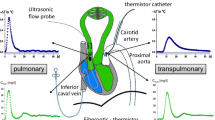Abstract
The effect of different temperatures of perfusing fluid was tested on the pulmonary circulation of the rat. With increasing temperature, a decrease in overall pulmonary vascular resistance was observed, which depended on the associated reductions of arterial, venous and capillary vascular resistances. The highest sensitivity to temperature changes was exhibited by the venous segment. The overall sensitivity of pulmonary vessels to temperature caused a reduction in hydraulic resistance of about 1% for each 1°C temperature increment. Compliance of pulmonary vessels increased when perfusate temperature was increased from between 25 and 35°C to 45°C, probably due to a direct effect of temperature on the stiffness of the vessel walls.




Similar content being viewed by others
References
Bhattachrya J, Staub NC (1980) Direct measurement of microvascular pressures in the isolated perfused dog lung. Science 210:327–328
Bradley DE, McNary WF, El-Bermani AW (1970)The distribution of aceticholinesterase and cathecolamine containing nerves in the rat lung. Anat Rec 167:205–207
Chen RYZ, Chien S (1978) Hemodinamic function and blood viscosity in surface hypothermia. Am J Physiol 235:H136–H143
De Pasquale NP, Burch GE, Hyman AL (1965) Pulmonary venous responses to immersion hyperthermia and hypothermia. Am Heart J 70:486–493
El-Bermani AW (1978) Pulmonary non-adrenergic innervation of rat and monkey. Thorax 33:167–174
Fuhner H, Starling EH (1913) Experiments on the pulmonary circulation. J Physiol (London) 47:216–223
Goetz RH, Rohman M, Goetz VM, Dee R, State D (1962) The effects of temperature changes on the pulmonary circulation. Surg Gynecol Obstet 62:595–601
Greenlees KJ, Tucker A, Robertshaw D, Vader CR (1985) Pulmonary vascular responsiveness in cold-exposed calves. Can J Physiol Pharmacol 63:131–135
Hakim TS, Michel RP, Chang HK (1982) Partitioning of pulmonary vascular resistance in dogs by arterial and venous occlusion. J Appl Physiol 52:710–715
Haynes J, Aubrey E Taylor, Dixon D, Voelkel N (1993) Microvascular hemodynamics in the sickle red blood cell perfused isolated rat lung. Am J Physiol 264:H484–H489
Howell JBL, Permutt S, Proctor DF, Riley RL (1961) Effect of inflation of the lung on different parts of pulmonary vascular bed. J Appl Physiol 16:71–82
Kirshenbaum B, Doetsch F, Lois C, Alvarez-Buylla A (1999) Adult sub ventricular zone neuronal precursors continue to proliferate and migrate in the absence of the olfactory bulb. J Neurosci 19:2171–2180
Martinez-Ruiz R, Sillau AH, Rico-Orsini MA, Tristano-Castiglion S, Sanchez de Leon R (1996) Effects of hypothermic perfusion on pulmonary circulation in isolated rabbit lung. Rev Esp Fisiol 52:1–8
McLean JR (1986) Pulmonary vascular innervation. In: Bergofsky H (ed) Abnormal pulmonary circulation. Churchill-Livingstone, London, pp 27–81
McMurtry IF, Reeves JT, Will DH, Grover RF (1975) Hemodynamic and ventilatory effects of skin cooling in cattle. Experientia 31:1303–1304
Palo M, Lauri T, Timisjarvi J (2000) Effects on dogs of surface-induced hypothermia and rewarming on the right heart function and pulmonary circulation. Eur J Appl Physiol 81:391–396
Pennington DG, Hyman AL, Woolverton WC (1971) Pulmonary vascular responses to selective lung cooling in intact dogs. Proc Soc Exp Biol Med 137:1375–1380
Stern S, Braun K (1970) Pulmonary arterial and venous response to cooling: role of alpha-adrenergic receptors. Am J Physiol 219:982–985
West JB (1985) Respiratory physiology—the essentials, 3rd edn. Williams and Wilkins, Baltimore
Walsh GM, Tsuchyia M, Frohlich ED (1976) Direct fick application for measurement of cardiac output in rat. J Appl Physiol 40:849–853
Will DH, McMurtry IF, Reeves JT, Grover RF (1978) Cold-induced pulmonary hypertension in cattle. J Appl Physiol 45:469–473
Author information
Authors and Affiliations
Corresponding author
Rights and permissions
About this article
Cite this article
Rubini, A. Effect of perfusate temperature on pulmonary vascular resistance and compliance by arterial and venous occlusion in the rat. Eur J Appl Physiol 93, 435–439 (2005). https://doi.org/10.1007/s00421-004-1235-x
Accepted:
Published:
Issue Date:
DOI: https://doi.org/10.1007/s00421-004-1235-x




